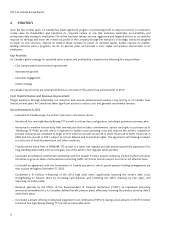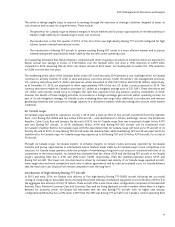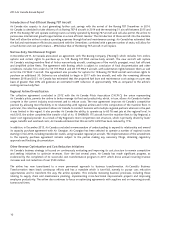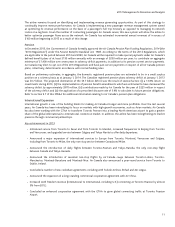Air Canada 2013 Annual Report Download - page 18
Download and view the complete annual report
Please find page 18 of the 2013 Air Canada annual report below. You can navigate through the pages in the report by either clicking on the pages listed below, or by using the keyword search tool below to find specific information within the annual report.2013 Air Canada Annual Report
18
• Adjusted net debt amounted to $4,351 million at December 31, 2013, an increase of $214 million from December 31,
2012. The increase in adjusted net debt was largely due to the purchase of four Boeing 777 aircraft in 2013. The airline’s
adjusted net debt to EBITDAR (excluding benefit plan amendments) ratio was 3.0 at December 31, 2013 versus a ratio of
3.1 at December 31, 2012. Air Canada uses this ratio to manage its financial leverage risk and its objective is to maintain
the ratio below 3.5. Adjusted net debt (total debt less cash, cash equivalents and short-term investments plus capitalized
operating leases) is a non-GAAP financial measure. Refer to section 9.3 of this MD&A for additional information.
• Unrestricted liquidity (cash, short-term investments and undrawn lines of credit) of $2,364 million at December 31, 2013
or 19% of annual operating revenues (December 31, 2012 – $2,018 million or 17% of annual operating revenues).
Unrestricted liquidity refers to the sum of cash, cash equivalents, short-term investments and the amount of available
credit under Air Canada’s revolving credit facilities. At December 31, 2013, cash and short-term investments amounted to
$2,208 million and undrawn lines of credit amounted to $156 million. At December 31, 2012, cash and short-term
investments amounted to $1,973 million and undrawn lines of credit amounted to $45 million. Air Canada’s principal
objective in managing liquidity risk is to maintain a minimum unrestricted liquidity level of $1.7 billion.
• Return on invested capital (“ROIC”) at December 31, 2013 of 11.0% versus 7.9% at December 31, 2012. Air Canada’s goal
is to achieve a sustainable ROIC of 10% to 13% by 2015. Refer to section 20 “Non-GAAP Financial Measures” for
additional information.
Fourth Quarter 2013 Financial Summary
The following is an overview of Air Canada’s results of operations and financial position for the fourth quarter of 2013
compared to the fourth quarter of 2012.
• Operating revenues of $2,894 million, an increase of $55 million or 2% from the fourth quarter 2012.
• Passenger revenues of $2,560 million, an increase of $47 million or 1.9% from the fourth quarter of 2012, on traffic
growth of 2.5% as yield declined 0.6% year-over-year.
• An ASM capacity increase of 3.5% from the fourth quarter of 2012, in line with the 3.0% to 4.0% fourth quarter 2013
ASM capacity increase projected in Air Canada’s news release dated November 8, 2013.
• A RASM decrease of 1.7% from the fourth quarter of 2012, reflecting a 0.9 percentage point decline in passenger load
factor and the yield decrease of 0.6%.
• An adjusted CASM reduction of 2.3% from the fourth quarter of 2012, in line with the 2.0% to 3.0% decrease projected in
Air Canada’s news release dated November 8, 2013. Refer to section 20 “Non-GAAP Financial Measures” for additional
information.
• Operating income of $135 million compared to operating income of $47 million in the fourth quarter of 2012, an
improvement of $88 million. In the fourth quarter of 2013, Air Canada recorded an operating expense reduction in benefit
plan amendments of $82 million.
• A net loss of $6 million or $0.02 per diluted share compared to a net loss of $60 million or $0.22 per diluted share in the
fourth quarter of 2012. The net loss in 2013 included foreign exchange losses of $55 million due to a weaker Canadian
dollar and the favourable impact of benefit plan amendments of $82 million. The net loss in 2012 included foreign
exchange gains of $9 million.
• EBITDAR (excluding benefit plan amendments) of $277 million compared to EBITDAR of $283 million in the fourth
quarter of 2012, a decrease of $6 million. Refer to section 20 “Non-GAAP Financial Measures” for additional information.
Air Canada estimates that December 2013 EBITDAR was negatively impacted by $15 million as a result of severe weather
conditions.
























